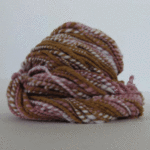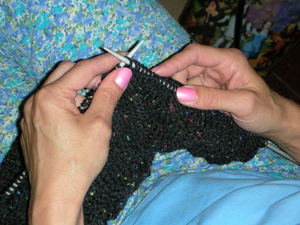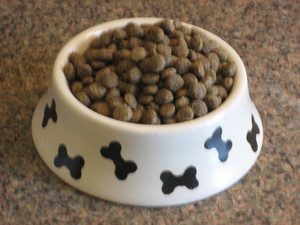Most of the time, when you pick up a knitting pattern, it will tell you exactly what kind of yarn you should buy in order to have your finished product turn out the right size. But maybe you can’t find that particular brand of yarn at your local yarn store. Or even worse, what if it doesn’t have the name of a yarn at all? Maybe it says something like “200 yards of worsted weight yarn,” or “500 yards of lace weight yarn.” How do you know what to buy?
Fortunately, figuring out yarn weights is relatively simple once you understand the standard terms. “Weight” refers to the thickness of the yarn, and is usually dependent on the “ply” of the yarn-that is, how many strands have been plied or twisted together to make the yarn. Many times, a yarn will say what weight it is on its label; however, you can still figure it out if it doesn’t.
In order to determine an unknown yarn’s weight, you need to figure out its “wpi”-wraps per inch. Take a relatively small-diameter object, like a pencil or a broomstick, and wrap the yarn around it closely, but taking care not to pull it too tight. Once you’ve gotten enough wrapped around the object, measure how many wrapped strands there are in an inch. That’s your wpi!
There are about eight standard weights of yarn. You may run into some slight variations on these, like heavy worsted weight, but these are the most common.
Lace
2 ply; 18+ wpi
Lace weight is very, very fine yarn, little more than thread. As its name implies, lace weight yarn is most commonly used for knitting…well, lace. It’s very uncommon to use lace yarn to knit solid fabrics, because it would be extremely time consuming, with very small needles. There is no standard needle size, since a wide variation of needles can be used to produce different appearances of lace. A popular lace weight yarn is Rowan Kidsilk Haze.
Fingering
4 ply; 16 wpi
Fingering weight is the most commonly used yarn for sock knitting. Therefore, you may often see yarn labeled as “sock yarn,” which usually means it’s a fingering weight yarn.
Standard needle size is anywhere from 0 (2.0mm) to 3 (3.25mm).
A popular fingering weight yarn is Dream In Color Smooshy.
Sport
5 ply; 14 wpi
Sport weight yarn may be used for some sock knitting, but it’s rare. With sport yarn, you start to venture into the world of gloves, mittens, some baby clothes, and occasionally hats. Sport weight yarn is a nice compromise between knitting at a very fine and time-consuming gauge, and using bulky and potentially unattractive yarns.
Standard needle size is 3 (3.25mm) to 5 (3.75mm).
A popular sport weight yarn is Knit Picks Shine Sport.
DK
8 ply; 11 wpi
DK weight yarn is somewhat difficult to tell from sport weight, if you’re not used to dealing with them. I’ve made the mistake of buying sport yarn when I needed DK; be careful to check the label or do research online before you buy.
Standard needle size is 5 (3.75mm) to 7 (4.5mm).
A popular DK weight yarn is Elsebeth Lavold Silky Wool.
Worsted
10 ply; 9 wpi
Worsted weight is the most popular and versatile of all yarn weights. Most patterns are written for worsted weight yarn. Hats, scarves, gloves, sweaters, bags-you name it, you can probably find a pattern for it written for worsted weight yarn. And it’s definitely the easiest kind of yarn to find.
Standard needle size is 7 (4.5mm) to 9 (5.5mm).
A popular worsted weight yarn is Cascade 220 Wool.
Aran
10 ply; 8 wpi
Aran is an oddly close relative of worsted weight yarn. It’s only a little bit thicker, and it has the same ply. Generally speaking, you can substitute aran weight yarn for worsted weight in nearly any pattern.
Standard needle size is 7 (4.5mm) to 9 (5.5mm).
A popular aran weight yarn is Malabrigo Merino Worsted (yes, despite its name, it’s considered an aran weight yarn).
Bulky
12 ply; 7 wpi
Bulky weight yarn is most useful for projects that you want to knit up quickly. It’s good for a variety of scarf patterns, and may be seen in some hat or even sweater patterns. Most patterns that call for bulky yarn are meant to be relatively quick projects, since the large yarn and bigger needles make your knitting go much faster.
Standard needle size is 10 (6.0mm) to 11 (8.0mm).
A popular bulky weight yarn is Lion Brand Homespun.
Super Bulky
5-6 wpi
Super bulky yarn is pretty easy to spot. It’s a fairly uncommon weight of yarn to use, since it doesn’t allow for much flexibility, and you have to use very large needles to achieve a good gauge. You might see it for blankets or chunky scarves.
Standard needle size is 11 (8.0mm) to 13 (9.0mm).
A popular super bulky weight yarn is Lion Brand Wool-Ease Thick & Quick.
Now that you are armed with all the necessary information about yarn weights, you should be able to substitute yarns into your knitting patterns with ease. Just remember that if you’re going to substitute yarns, it DOES matter what weight you use if you’re making a garment that needs to fit correctly-but if the relative size isn’t important, like a scarf, then you can use different weights or different needle sizes as you see fit. With a little experimentation, maybe a few mistakes, and this guide, you should be picking out your own yarns in no time!





